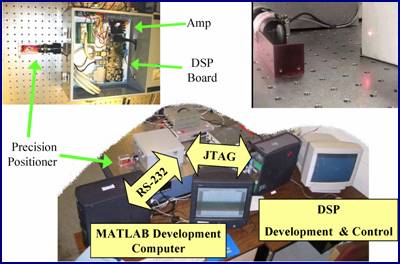Precision motion is an indispensable part of microelectronic systems and their manufacturing, for example, read/write head motion in disk drives, chip placement motion in surface mount machines, laser drill motion in electronic packaging, scanning motion in confocal microscope, etc. Precision motion is also critical for micro-assembly and Micro-Electro-Mechanical-Systems (MEMS) actuation in applications to RF, micro-optic and micro-fluidic devices. With the continuing demand on high performance and low cost, the requirement on the motion subsystem, in terms of speed and precision, is also ever more stringent. Due to the high volume of data or parts these systems have to process, even a few percentage of throughput increase can have major economic impacts in terms of the overall system performance improvement and production cost saving.
A key impediment to performance improvement is the inherent flexible dynamics in such systems. This is especially true in high precision applications where even minute vibration in seemingly stiff structures can compromise the motion requirement. In addition, the flexible dynamics frequently vary from one machine to another, making their incorporation into the control design difficult. Other major challenges to the control system design include friction (with its inherent hysteretic behavior), actuator saturation, and noise.
A tight feedback control loop can achieve good nominal response and noise and disturbance rejection, but the performance is limited by model uncertainty and noise. Feedforward compensation is typically applied to achieve additional performance gain. Many feedforward control schemes have been proposed, including time optimal control, inverse dynamics, finite impulse response filter, and output matching. However, a design methodology that can achieve fast settling time in the presence of nonlinearity, flexible dynamics, inequality constraints, and model uncertainty remains elusive. In the case of MEMS actuators, these factors become even more difficult to address due to the absence of adequate position feedback sensors in many applications.
We have worked with a leading electronics packaging machine manufacturer for several years addressing the precision motion problems faced by its machines. The challenges are: tight performance requirement in terms of settling band and settling time, large motion range relative to the settling band, output velocity and acceleration saturation constraints, friction and hysteresis nonlinearity, and variation of the resonant dynamics from machine to machine. We have developed new identification, iterative learning, and on-line adaptive control techniques that significantly improve what could be currently achieved. These algorithms have been incorporated into the company’s latest products. We are currently focusing on the friction modeling and compensation, as well as motion planning (similar to the so-called motorized traveling salesman problem – but for ½ million – 1 million points!).





